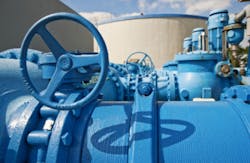Back in the mid-1960s, I was employed as an apprentice mechanic in a Birmingham, AL, steel mill. When one of our water pumps failed in the cooling ponds one day, my boss gave me a requisition order and the keys to a company truck. He told me to go into the city and purchase another pump at the industrial supply house.
He said, "Get a water pump that pumps 30 psi [pounds per square inch] at 400 gpm [gallons per minute]." He wrote it on the requisition.
At the industrial supply house, the sales rep escorted me to the pump showroom. He said, "This is the water pump you need. It generates 70 feet of head at 400 gpm. Do you need a coupling and motor too?"
I said, "Wait a minute! I don’t need 70 feet of head. I want 30 psi at 400 gpm. What is 70 feet of head?" I thought the sales rep was trying to do a "bait-and-switch" on me. The requisition chit clearly stated 30 psi. I wondered why the sales rep used different terms. Indignantly, I walked away and went to a competing industrial supply house — where I repeated the same verbal exchange with their sales rep.
I know I’m not alone. This misunderstanding about head and pressure occurs daily all over the country … and, indeed, all over the world.
Pump users want pressure. Pump manufacturers supply feet (or meters) of head. In the final analysis, they are the same, just expressed from two different points of view. As someone who specifies and/or installs pumps, you need to know how these terms relate to each other.
Origins of head, pressure
Ancient Rome and Greece were supplied with running water in giant aqueducts, which carried fresh water from mountain lakes and streams down into the city. Underground clay pipes would carry the water by gravity to the different neighborhoods. The water would collect in fountains for the housewives to carry away daily in clay jars. A centurion normally guarded the fountain to prevent water theft or contamination.
That was 2,600 years ago — when water flowed by gravity, the flow was dispensed in jugs and barrels, and there were no pressure gauges or instrumentation. Still, it was generally understood that force (rated in units of energy) was required to elevate a quantity (volume or weight) of water against gravity. A certain amount of energy (force) was required to raise a jug of water from the fountain up into an oxcart or onto the housewife’s head.
In Greece 2,200 years ago, Archimedes developed the first practical constant-flow pump. The "Archimedes screw" would elevate water from a river up into an irrigation canal for agriculture. The screw was used as a bilge pump on the king’s barge. It would also lift well water up to the surface for the wives to carry home and use to pour their husbands’ bath. (The topic of women’s liberation requires another article.)
Beginning with the Archimedes screw and the Egyptian noria (another pumping device), pump force was rated in units of energy against gravity. For this reason, pumps are rated in "head" to express what we call pressure.
In 1643 the French inventor and mathematician Blaise Pascal, realized that air (the atmosphere) also has weight and that its force is applied in all directions, not just down with gravity. So, he clarified the concept of "pressure" as it is used in the physical sciences: He defined pressure as a force applied to an area, such as a pound of force applied to a square inch of area: thus, pounds per square inch.
A useful formula
Today, modern pump companies continue to rate a liquid’s force as a unit of energy against gravity. If we apply this same force in another direction — such as against the interior sidewall of a pressurized tank — we would use the term "pressure."
In simple terms, the mathematical constant 2.31 converts a unit of energy against gravity into a unit of force against any other area. This constant converts a foot of head of water into pressure: Head in feet of water divided by 2.31 equals pressure in psi, and pressure in psi times 2.31 equals head in feet.
If the liquid is not water (examples: paint, chocolate syrup or gasoline), the liquid’s specific gravity must be factored into the formula.
The constant 2.31 comes from the following: A square foot of area contains 144 square inches; a cubic foot of ambient-temperature water weighs 62.38 (62.4) pounds per cubic foot at 70 F at sea level.
If I poured 1 pound of water into a tall, narrow vessel that occupies 1 square inch of floor space, I would fill that vessel to 2.31 feet of elevation. Now let’s apply this information with some examples.
Imagine you were on a clear mountain lake taking a ride in a glass-bottomed boat. If the viewing windows were 6 feet below the water’s surface, how much pressure would be acting on the glass panes? Answer: The pressure acting against the windows would be 2.6 pounds per square inch, or 6 feet ÷ 2.31 = 2.6 psi.
The pump rep was right
Here’s another example: Most communities will have an elevated tank of ambient water that supplies water pressure to the communities and neighborhoods below the tank. If the water in the tank is 150 feet above a kitchen faucet in one of the homes, what is the water pressure at the faucet (assuming no other influences on pressure)? Answer: 150 ÷ 2.31 = 65.8 psi.
A standard pressure gauge would record 66 psi. There would be 66 psi of water pressure available at the kitchen faucet, until someone opens the faucet and water flows. As the faucet is opened and water begins moving through the pipes, there would be a slight pressure drop due to friction between the water and the pipe’s internal walls.
Now let’s work in the other direction. If I want to buy a pump that develops 30 psi to pump water, what is my pump rating? What pump should I buy?
30 psi x 2.31 = 70 feet
If you need a pump to develop 30 psi of water pressure, then buy a pump that develops 70 feet of head.
So, it turns out that back in 1965, the pump sales rep was trying to show me the correct pump for my application.
Differential pressure
Allow me to refine a couple of points:
Pumps develop differential head, or differential pressure. This means the pump takes suction pressure, adds more pressure (the design pressure), and generates discharge pressure. So, the discharge pressure is equal to the suction pressure plus the pump’s design pressure. The discharge pressure of the pump should be approximately equivalent to the total dynamic head (TDH) required by the system (tanks, pipes, elbows, valves, flanges and fittings).
To monitor and control your pump, your pump should have a suction pressure gauge and a discharge pressure gauge installed on the pump. You are concerned with the differential.
Let’s say your pump is designed to develop 40 psi. Let’s say there are 3 psi of pressure in the liquid as it arrives into the pump. The suction pressure gauge will read 3 psi. The pump is designed to add 40 psi of pressure. The discharge gauge would read 43 psi. The differential is 40 psi.
If the pressure entering the pump is 25 psi, the discharge gauge will read 65 psi. The differential is 40 psi.
Sick pumps to behaving ones
I work as a pump consultant. Frequently I’m called to analyze a problem with a sick pump. I usually arrive to find the sick pump has no gauges installed. Or, maybe the sick pump has only a discharge gauge. The pump operator, installer or owner doesn’t know what the pump is doing. This is normally the source of the problem.
Operating a pump without gauges is like driving a car without a dashboard control panel. I mean, you need a timer and a temperature gauge just to cook a pan of biscuits in the oven.
After we control and monitor the differential pressure across the pump, the pump calms down and behaves. The discharge gauge is useless without the suction gauge. Remember, it is the differential pressure, or differential head.
Finally, if your system requires 50 feet of head at 600 gpm, then you will want to purchase a pump with best efficiency coordinates of 50 feet at 600 gpm on the pump performance curve. When reading these curves while choosing a pump, there is a certain optimum zone on the pump-curve graph that you want to stay in. That zone is where the pump operates most efficiently. Pump efficiency is the best combination of head and flow at the least energy consumption. Buy and use efficient pumps.
Larry Bachus is The Pump Guy®, a pump consultant, lecturer and inventor based in Nashville, Tennessee. He’s a retired member of the American Society of Mechanical Engineers (ASME), and fluent in both English and Spanish. Bachus may be reached at 615-361-7295, by email at [email protected] or via the Web at www.bachusinc.com.


